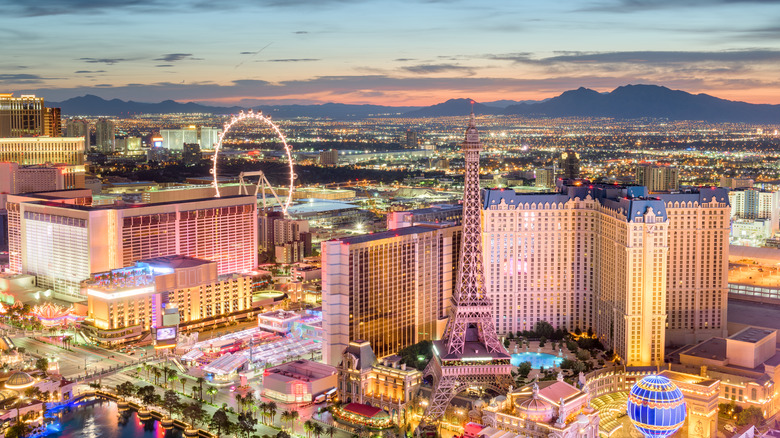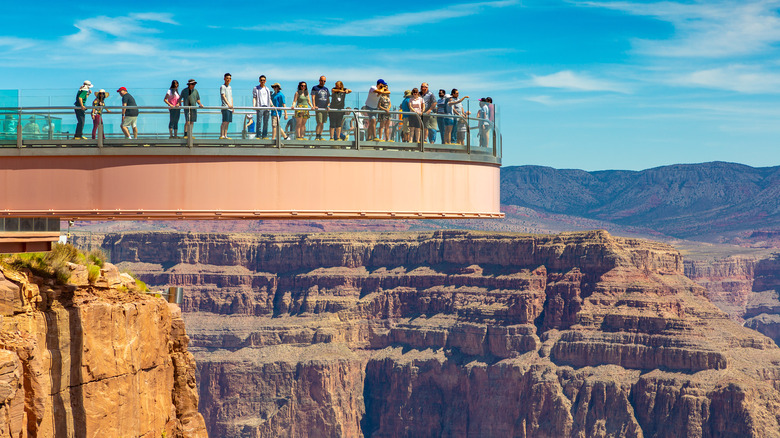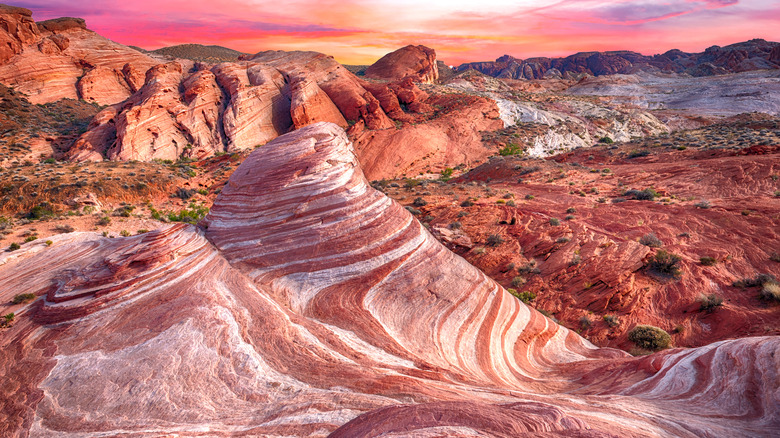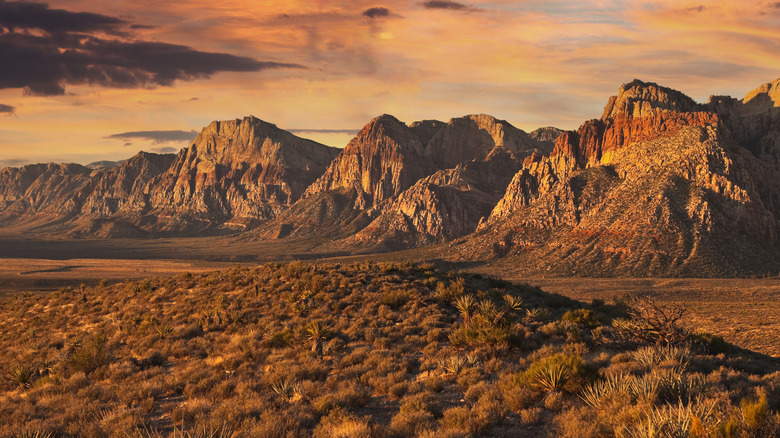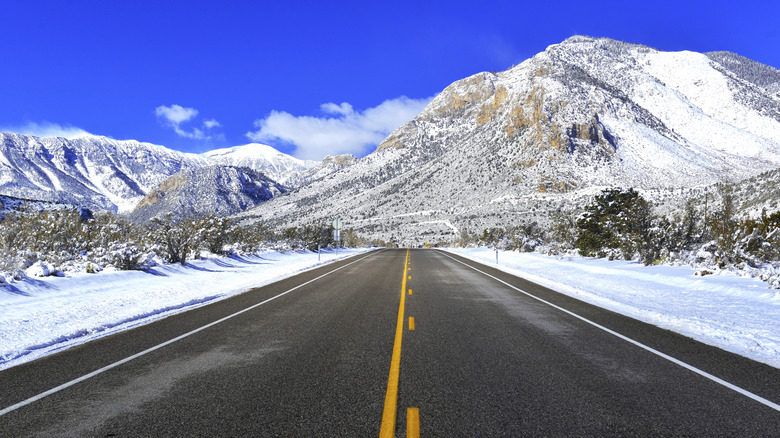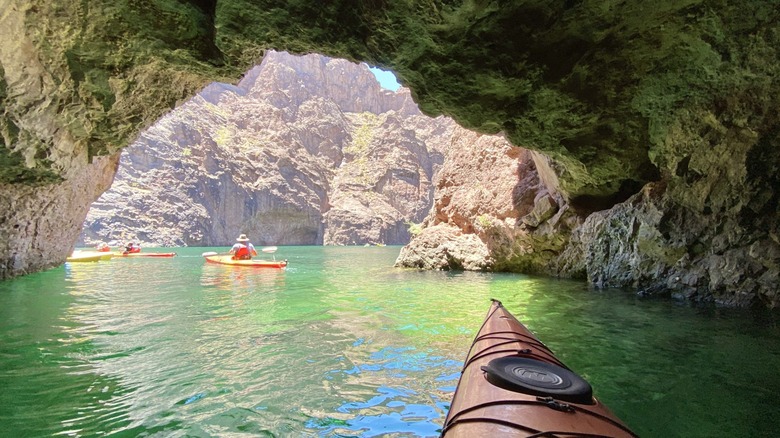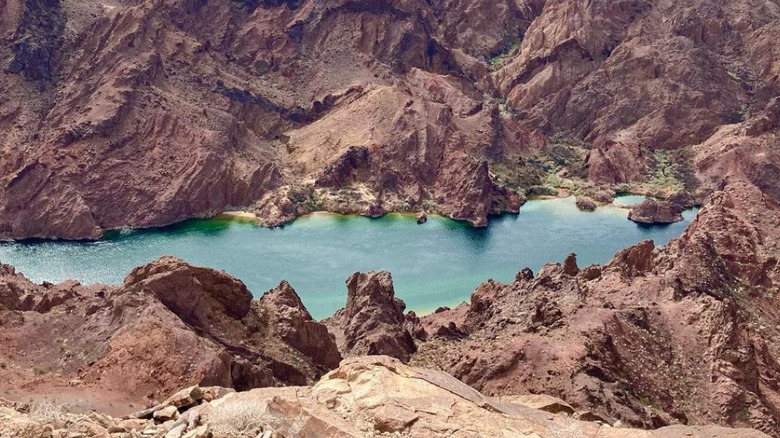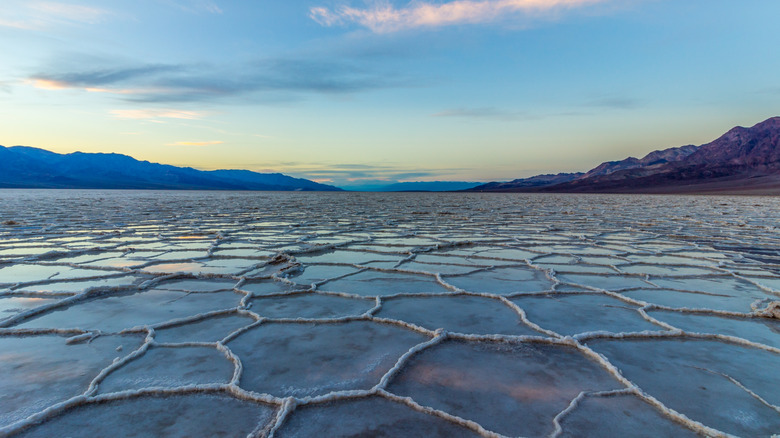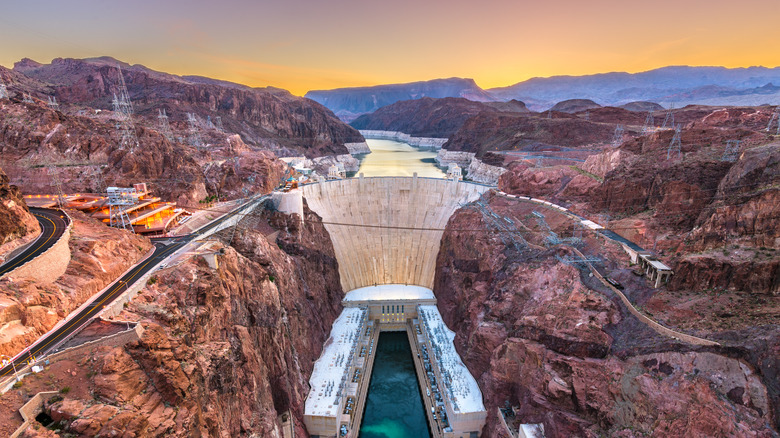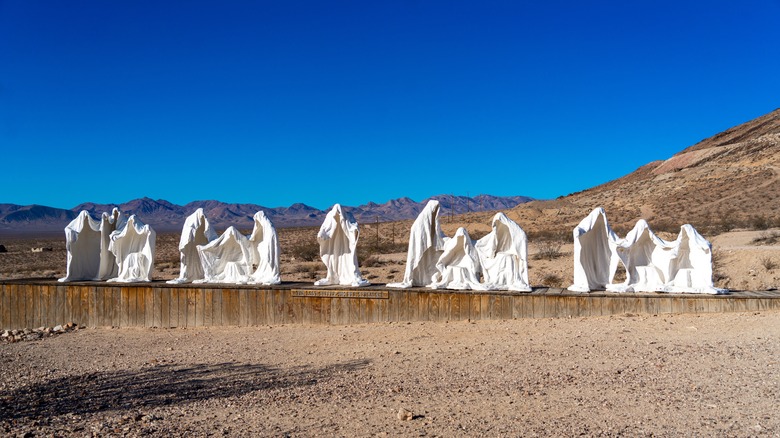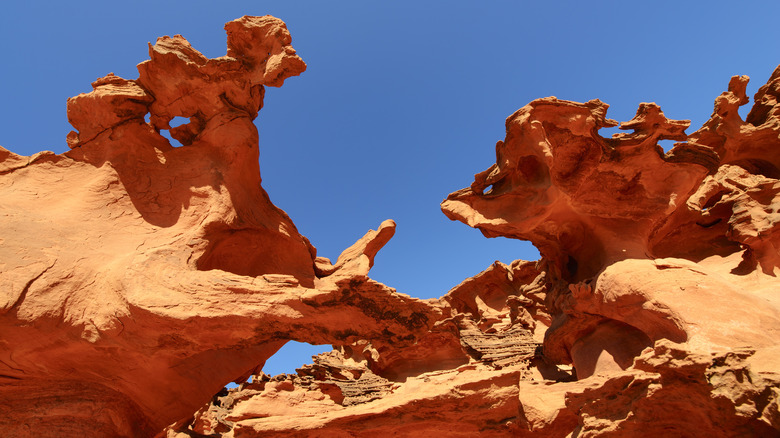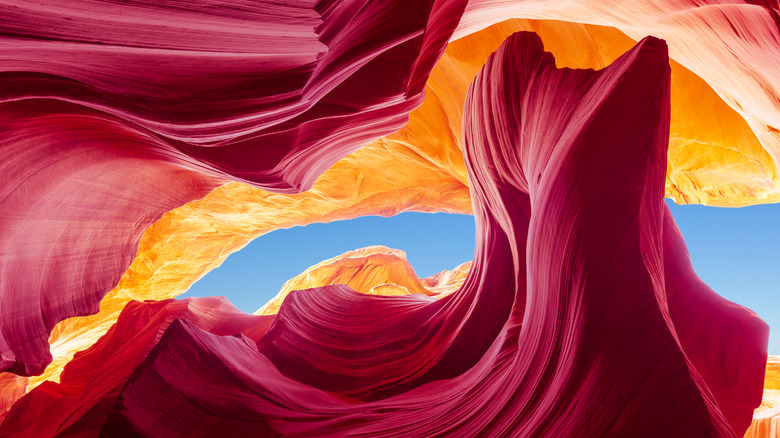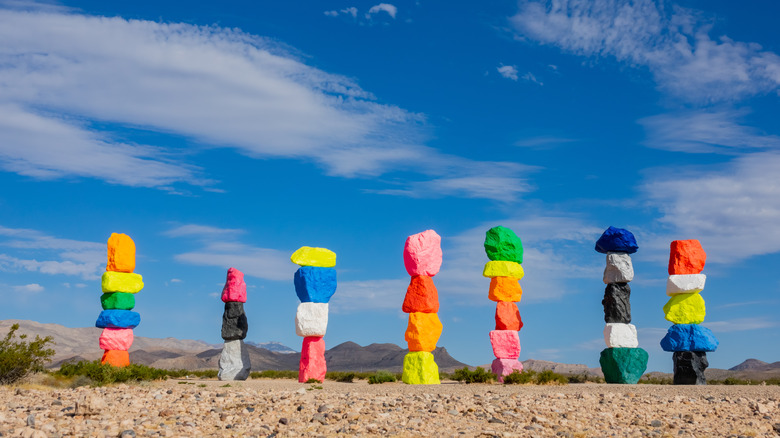12 Best Outdoor Activities To Do On A Trip To Las Vegas
The beauty of Nevada and Las Vegas often gets overshadowed by the neon lights of the strip and the various adrenaline-pumping and entertainment activities that are constantly happening in the city. However, Vegas is much more than just gambling and what you can find on the strip. The city is surrounded by a whole lot of natural beauty that really isn't all that hard to find, so long as you can tear your eyes away from the bright lights of Vegas itself.
Gorgeous desert landscapes, three official U.S. wonders, and numerous national and state parks are close enough to Vegas for a day trip. This makes the popular destination prime for travelers who want to see it all, the flashing lights of the city, the excitement that comes from being in the heart of Sin City, and a beautiful escape into nature.
If you do intend on braving the desert and finding some great nature spots in the surrounding areas, be sure to bring along plenty of water and wear appropriate clothing for the venture — the desert is hot and unforgiving. Traveling with a friend or a group is also vital for a safe trip into the outdoors. Once you're prepared to leave the neon strip behind and head into the outdoors, any of the exciting and awe-inspiring activities on this list would make for a memorable Vegas vacation — you just may have to set aside a full day to explore some of them!
The Grand Canyon
Las Vegas itself is one of the most popular tourist attractions in the United States, but it's pretty close to another major U.S. destination as well. The west rim of the Grand Canyon is about a two-hour drive from Vegas, but that will seem like nothing once you get there and see one of the United States' official natural wonders. Luckily, the west rim is also where the famous Skywalk is, so you can quite literally walk over the Grand Canyon and have a view only possible due to the see-through walkway that stretches over the edge of the canyon.
You can certainly drive from Vegas to the Grand Canyon, taking in all the desert air has to offer along the way, and your road trip will include a few other spots mentioned on this list, like the Hoover Dam and Lake Mead. If you're not willing to take the drive, though, there's no worry — you can get to the Grand Canyon much faster and in greater style via helicopter. There are plenty of helicopter tours available from Vegas to the canyon, they're just going to be more pricey than driving yourself. The price just might be worth it, though, as you save time and will be able to see the canyon from a wonderful perspective.
Valley of Fire
Mother Earth is an artist, and she truly outdid herself with the Valley of Fire. The state park is less than an hour away from Las Vegas and consists of red and pink striped rocks that wave and zigzag throughout the formations and canyons. The Valley of Fire is arguably the most beautiful state park in the state and you'd be missing out on a truly breathtaking experience if you leave Vegas without checking it out.
The park is accessible to all and you're able to simply drive through the park and stop when it suits you. It's only around 15 miles to drive around and every second is filled with stunning scenery. There are places to stop for those who want to take a hike or two, which really allows visitors to take in all the gorgeous sights the park has to offer. The Rainbow Vista Trail and Fire Wave Trail are both short at just over a mile, are geared toward beginner hikers, and lead to some amazing views of the marbled red sandstone the park is so well known for. Experienced hikers may consider going on one of the longer trails like the Natural Arches trail. Either way, travelers need to remember to bring water and prepare for intense heat in order to stay safe.
Red Rock Canyon
Only a stone's throw away from Las Vegas and less than a 20-minute drive, Red Rock Canyon State Park is one of the most convenient ways to get out of the city and see some top-tier nature views. The 14-mile drive through the park is worth taking to see all you can see, but we also recommend taking one or two of the great hikes throughout the park. Not only does the park include some pretty spectacular rock formations, but a waterfall as well –- in the desert, a waterfall can seem like paradise.
One of the more interesting elements of Red Rock Canyon, apart from the canyon and atmosphere itself, is a collection of petroglyphs on the rocks that date back nearly 1000 years. Seeing the stone carvings is not difficult, you just need to head to the Petroglyph Wall Trail, which is just a .1-mile walk from the road. You'll find carvings as well as paintings on the trail and it is a very short detour on the main road of Red Rock Canyon that is incredibly worth it.
Mount Charleston
Just north of Red Rock Canyon is Mount Charleston, where you will find a completely different atmosphere and gorgeous scenic views. Instead of the brilliant red rock formations of the canyon, you will be met with a true changing of the seasons! Charleston Peak is typically snow-capped and the mountain sees the trees change with the seasons, which leads to visitors' experiences being vastly different from season to season. This scenic change, especially the snow, can be totally mind-blowing, especially considering you are very much surrounded by the Mojave Desert.
Both hiking and camping are popular activities on Mount Charleston, and the outdoor-lovers may consider foregoing a hotel completely in favor of roughing it on the mountain. With the drive being well under an hour, coming into Las Vegas daily from a campsite wouldn't be out of the question for some travelers. Whether you want to stay the night or just briefly visit, though, seeing Mount Charleston is one way to incorporate the great outdoors into a Vegas trip.
Black Canyon and the Emerald Cave
If you'd rather explore via waterways, an Emerald Cave tour may be just right for you. Located under an hour's drive from Las Vegas in the Black Canyon, the Emerald Cave is named such because of the glowing green color of the water. The vibrant emerald water is the result of a type of algae that grows in the area and the way the sun hits the rocks – when the conditions are just right, the water is the perfect shade of green.
Though the water is deep, Emerald Cave itself is a very small cave. Exploring the cave consists of entering, looking around at the glowing water, and exiting the cave. It's still worth venturing to the cave, though, because the view of the surrounding canyon from the water is surreal.
The best way to explore Emerald Cave and Black Canyon is by kayak, and there are plenty of kayak tours that take willing visitors to see the canyon via the Colorado River — though you can go without a tour if you are an experienced kayaker and are confident in your abilities to find your way. The route is typically a few miles of easy paddling, but those taking the trip during the summer would do well to protect themselves from sun and heat exposure because it can get over 100 degrees in the canyon.
Gold Strike Hot Springs
Near Emerald Cave is an adventure for those looking for a more challenging outdoor endeavor, as the Gold Strike Hot Springs Trail offers a breathtaking reward at the end of a hike that is not for the faint of heart. To reach the hot springs, hikers must descend around 600 feet through rock scrambles and even numerous fixed ropes required to descend and climb large rocks on the trail.
It'll take three or four hours to hike one way, with your reward being a dip in the hot springs. Don't wear yourself out, though, because you will have the same amount of hiking on the way back, and this time you'll be traveling upwards. Travelers will want to note that the trail is likely best avoided during the summer months, as it gets too hot to safely maneuver –- there's also a risk for rattlesnakes and flash floods. Make sure to bring plenty of water and do not hike the trail alone.
Death Valley National Park
Another natural wonder of the U.S., Death Valley is very much worth a visit if you're looking to get away from the neon lights of Vegas for a day trip during your stay. Though morbidly named, the beauty of the many landscapes that Death Valley offers is unimaginable, you really do have to experience them for yourself. With that being said, the name does have some truth to it — the national park is one of the hardest to see in that it is one of the hottest places in the U.S. and one of the driest. It's also important to note that cell service is very limited in Death Valley. However, if you prepare accordingly and bring enough water, appropriate protective clothing, and take the right precautions, the valley is perfectly safe.
Death Valley is one of the largest national parks at over 3 million acres and there are plenty of spots that are as beautiful as they are otherworldly. One of the neatest spots also happens to be one of the closest to Vegas at around two and a half hours from the strip. Badwater Basin is the lowest point of Death Valley and the entire United States, and it is completely flat. The salt flat offers an awesome spot for photography as the perspective is a wild one. The drive from Vegas to Death Valley is one full of beautiful scenery as well.
Hoover Dam and Lake Mead
As one of the world's engineering wonders, the Hoover Dam is something magnificent to behold. The destination is under an hour from Las Vegas and a lot of other notable outdoor wonders that made this list are in its vicinity, making the Hoover Dam well worth the short trip. The drive is well worth it, as you're guaranteed to see the awe-inspiring view of the dam in contrast to the gorgeous nature views surrounding it.
Taking a tour of the dam may be of some interest to travelers, but it is Lake Mead that holds the most value to a lot of nature lovers. No matter what kind of outdoor adventurer you are, you can find something you love at Lake Mead. From biking and hiking to swimming or just laying out by the water, the options at the gorgeous lake are pretty much endless. Some travelers prefer to be out on the water via boat, opting to either go by canoe, kayak, or even motor boat. If you prefer to keep your feet on land, though, the area has a gorgeous backcountry to explore.
Nevada's ghost towns
Interestingly enough, Nevada is home to more abandoned towns than ones that are thriving with people. This may make sense considering how much of the state is covered with desert and that one of its nearby draws is named after Death himself, but the many ghost towns are actually pretty cool to visit.
If you are heading to Death Valley from Las Vegas, you're in the prime position to visit Rhyolite, a ghost town that has been somewhat turned into an art installation with bottle houses. There are a few bottle houses in the town, but Tom Kelly's Bottle House is the most famous and is made from thousands of bottles from the town's saloon and nearby bars. Very close to Rhyolite is the Goldwell Open Air Museum, a collection of staggering sculptures in the desert including mirrors that reflect the surrounding atmosphere.
If you're looking for something closer to Vegas, Nelson Ghost Town is a great option. It's everything you would expect a well-preserved ghost town to be and has been in numerous film and TV productions over the years. You can explore the town and even take a tour of the nearby gold mines that made the town so profitable in its heyday.
Gold Butte National Monument
If you travel to Lake Mead for the day, making a little detour to hike around the nearby Gold Butte National Monument is a great idea. The stunning rock formations found here are one of Nevada's most low-key elaborate attractions, as they see very little traffic compared to all the other nearby natural attractions, which is a shame considering how amazing the natural national monument is.
Visiting Gold Butte is like walking into an art museum fully crafted by Mother Nature herself, as the area is full of sculptures made from the Mojave Desert's signature sandstone that has been worn away by water and wind over the course of millions of years. Here you can also see how some of the sandstone has been carved with ancient rock art.
There are two ways to see Gold Butte, and that's either by driving its namesake Backcountry Byway or hiking to some of the more impressive natural art sculptures. If you're planning to drive, make sure you have a 4-wheel drive vehicle, as the terrain of the path ranges from the paved road to completely unmaintained paths. Alternatively, hikers can get to some pretty spectacular views if they take one of the many trails off the road. One of the most popular is Little Finland Loop, which leads to some of the best natural sculptures and petroglyphs in the area.
Antelope Canyon and Horseshoe Bend
This one takes some commitment, but a tour of Antelope Canyon and Horseshoe Bend is not only breathtaking but almost a spiritual experience when you consider how extraordinary nature is in forming such a wonderful design. Tours can begin in Vegas, where participants are picked up for a long drive across the desert terrain to Antelope Canyon, where they are greeted by gorgeous rock formations.
A hike to Horseshoe Bend, a curved waterway that hugs the canyon like its namesake shape, will help prepare travelers for the five-hour drive back to Vegas – yes, you'll be spending 10 hours of travel time for this one. While that sounds like a trip within a trip, Antelope Canyon and Horseshoe Bend are definitely worth it for travelers who want to be fully immersed in the beauty of sandstone shaped over millions of years. Standing among the formations and looking up will give you one of the most intense views of Mother Nature's creativity in the area.
Trekking all the way to Antelope Canyon will take all day, so be prepared to carve out a chunk of your trip if you want to see the breathtaking shapes and colors that have naturally formed there. If you are able to sleep on the drive back you may be able to hit the Las Vegas strip when you get back, just in time for things to get lively under the neon lights.
Seven Magic Mountains
As beautiful as the red of the desert is, the vibrant colors of Seven Magic Mountain add something both jarring and wonderful to the Mojave Desert. The massive and interestingly placed art installation is made up of seven stacks of painted rocks that resemble a children's building block creation and stands over three stories high.
Seven Magic Mountains has stood tall in the desert for almost seven years and is located just south of Las Vegas, about 30 minutes from the strip. Artist Ugo Rondinone created the installation on a flat range with mountain ranges in the backdrop to symbolize the impact that humans have on the natural world, the clearly unnatural towers sharply contrasting the mountains in the distance, Mother Nature's labors of love.
The enormous art installation is visible from the road and is almost impossible to miss, so it naturally brings in a fair amount of people to appreciate it. Seven Magic Mountains is open to the public with viewers able to approach it on their own terms, and with little to no fuss to be had when visiting, it makes the perfect detour for a trip to Vegas or a great excuse to get out of the city for a little bit. Travelers looking for a great backdrop to take a selfie or group photo in order to commemorate their trip will find the art installation turns a great photo into a conversation piece.
